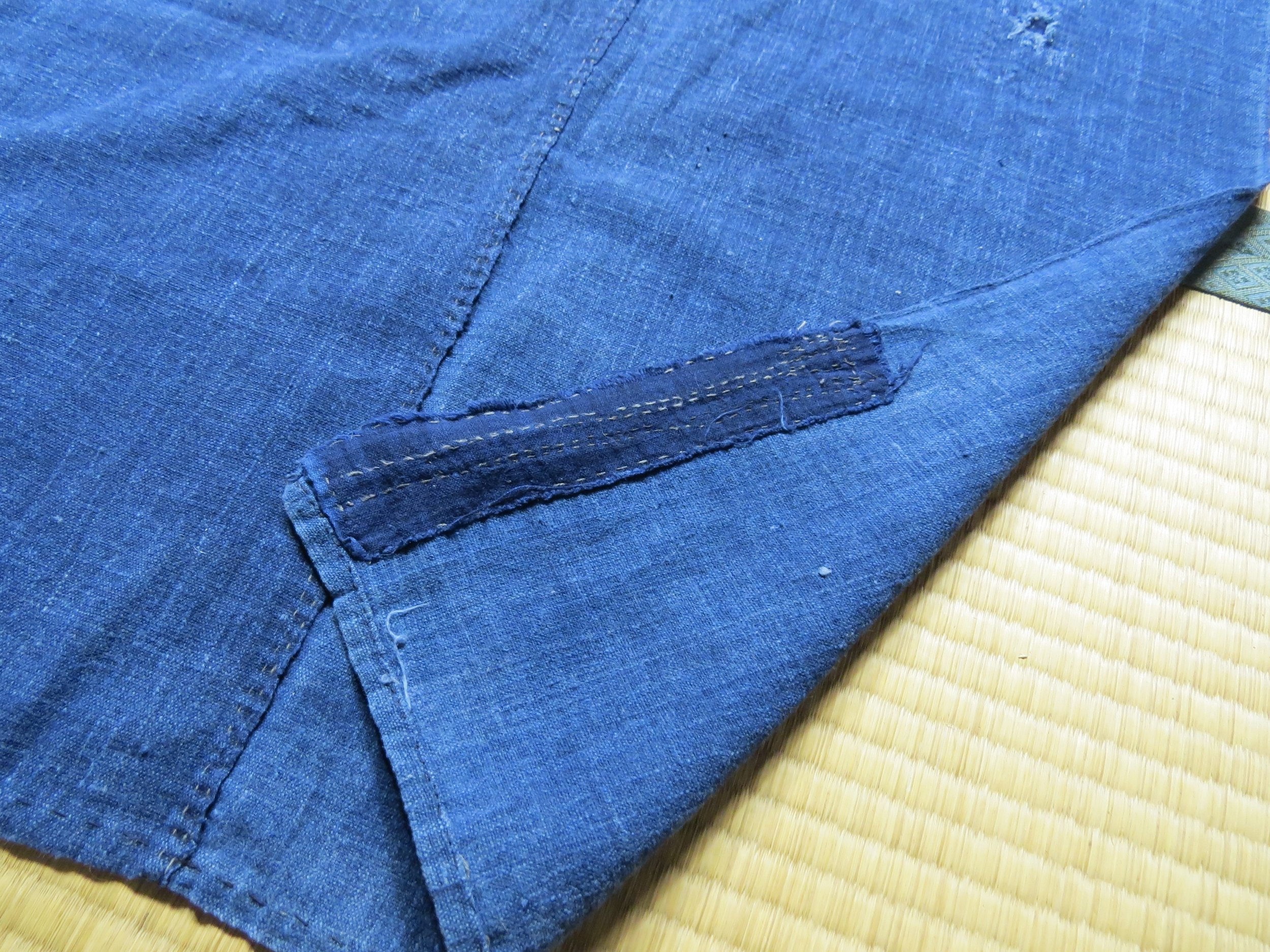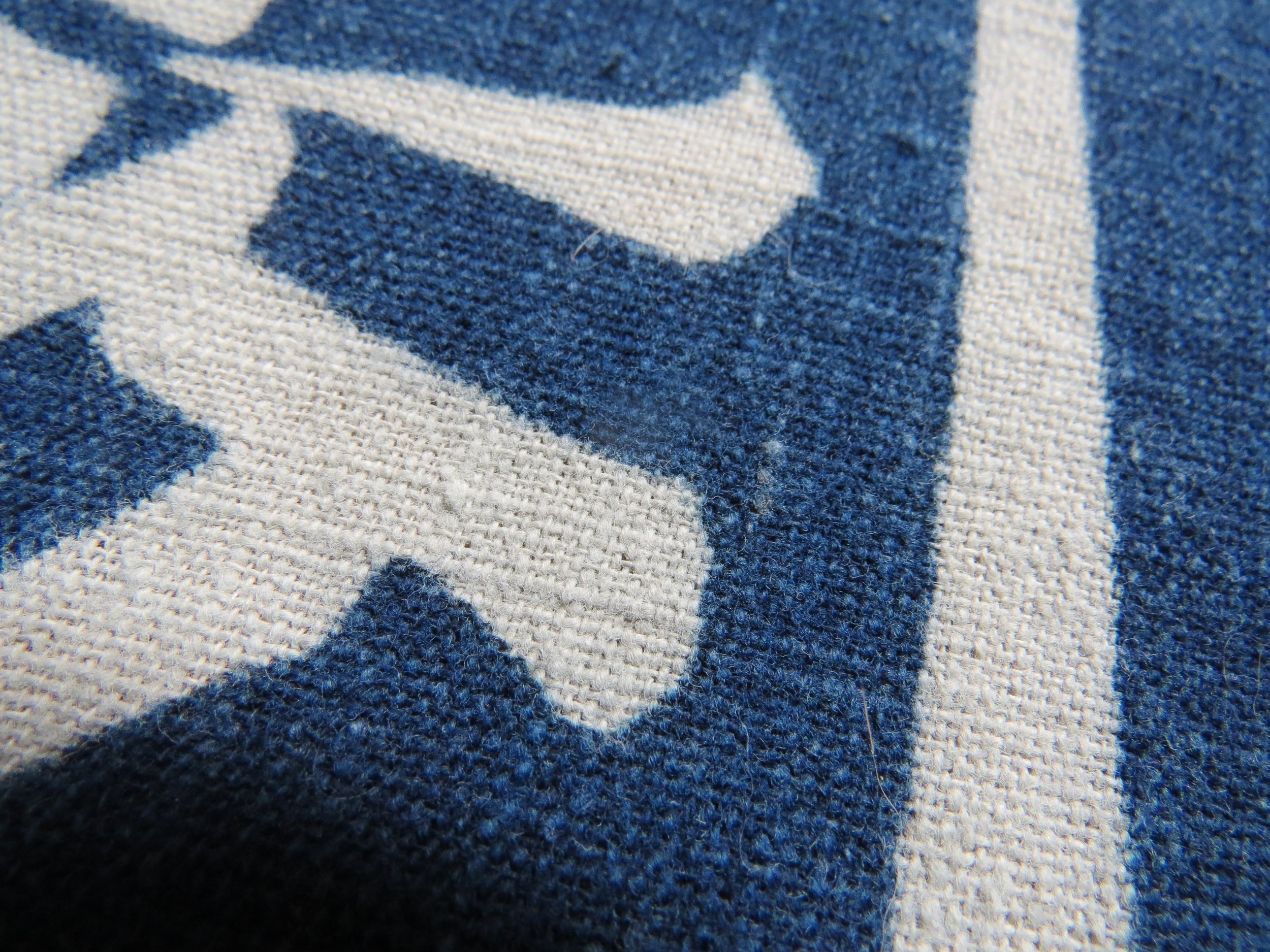 Image 1 of 15
Image 1 of 15

 Image 2 of 15
Image 2 of 15

 Image 3 of 15
Image 3 of 15

 Image 4 of 15
Image 4 of 15

 Image 5 of 15
Image 5 of 15

 Image 6 of 15
Image 6 of 15

 Image 7 of 15
Image 7 of 15

 Image 8 of 15
Image 8 of 15

 Image 9 of 15
Image 9 of 15

 Image 10 of 15
Image 10 of 15

 Image 11 of 15
Image 11 of 15

 Image 12 of 15
Image 12 of 15

 Image 13 of 15
Image 13 of 15

 Image 14 of 15
Image 14 of 15

 Image 15 of 15
Image 15 of 15
















Antique FUROSHIKI with Patches and Katazome - 4 panels wide
This is an antique hand woven cotton furoshiki made from 4 panels of homespun indigo-dyed fabric. There is a crest in one corner and a name in the other, done with stencils in a process known as katazome, and perhaps part of it was done freehand, in which case the process in called tsutsugaki. Both katazome and tsutsugaki involve using rice paste as a resist and dyeing over that, leaving some areas remaining undyed. Katazome uses stencils (or ‘kata’) for applying the rice paste (nori), and tsutsugaki uses a device similar to a pastry bag to apply the rice paste freehand, or perhaps over a traced outline.
Hand-woven homespun fabric, hand dyed in indigo, hand sewn. A lot of work, a lot of love went into this piece. I imagine these were prized possessions, back in the day. The two tone indigo furoshikis like this are the best. The light blues combined with the deep blues are so inviting to the eye. The texture and the hand of this fabric is really the BEST!! The string used to weave it was thick and the weight varied throughout, so the finished product has a lot of flavor. It feels so soft and warm.
Furoshiki (風呂敷) are traditional Japanese wrapping cloths traditionally used to wrap and/or to transport goods. (stole that from Wikipedia!! hahaha) This could be a great display piece, which could be hung on a wall or even used over the back of a couch or at the foot of a bed. It could also be incorporated into a larger quilt. As part of a Japanese antique collection it is perfect, and would make a killer gift for anyone as well. Wedding gift too. So many possibilities!~!
There are two mended, patched areas. You can see them in the photos. One of the mends, down at the corner, is artfully done, and a great way to fix this kind of tear, which i have seen often. They get that from someone pulling the corners to tie something. Therre are a loit of small =holes and wear spots, also many of which are photographed. None are very big, and they add to the flavor, the patina of age. But you can mend them, if you wish. The fabric is sturdy and will hold what you attach to it.
One thing I always notice, as a dyer myself, is the way the dark indigo tones around the crest are noticeably darker than the all blue areas around it. This must be because those strings were dyed at a different time than the rest of the strings, and maybe even in a different indigo vat. It makes me wonder about the process of dyeing and weaving…..what could be the reason??…..These cloths are so deep, have such rich narrative.
dimensions
126 cms long x 120 cms wide
50 inches x 47 inches
368 grams
Share this listing and my shop all over the place, Instagram, Facebook, Pinterest, the local corkboard, tell the cat.
Like and share all over the internet please!!! Facebook, Pinterest, Instagram!! Write a blog post about it! Open up the window and shout it out!
This is an antique hand woven cotton furoshiki made from 4 panels of homespun indigo-dyed fabric. There is a crest in one corner and a name in the other, done with stencils in a process known as katazome, and perhaps part of it was done freehand, in which case the process in called tsutsugaki. Both katazome and tsutsugaki involve using rice paste as a resist and dyeing over that, leaving some areas remaining undyed. Katazome uses stencils (or ‘kata’) for applying the rice paste (nori), and tsutsugaki uses a device similar to a pastry bag to apply the rice paste freehand, or perhaps over a traced outline.
Hand-woven homespun fabric, hand dyed in indigo, hand sewn. A lot of work, a lot of love went into this piece. I imagine these were prized possessions, back in the day. The two tone indigo furoshikis like this are the best. The light blues combined with the deep blues are so inviting to the eye. The texture and the hand of this fabric is really the BEST!! The string used to weave it was thick and the weight varied throughout, so the finished product has a lot of flavor. It feels so soft and warm.
Furoshiki (風呂敷) are traditional Japanese wrapping cloths traditionally used to wrap and/or to transport goods. (stole that from Wikipedia!! hahaha) This could be a great display piece, which could be hung on a wall or even used over the back of a couch or at the foot of a bed. It could also be incorporated into a larger quilt. As part of a Japanese antique collection it is perfect, and would make a killer gift for anyone as well. Wedding gift too. So many possibilities!~!
There are two mended, patched areas. You can see them in the photos. One of the mends, down at the corner, is artfully done, and a great way to fix this kind of tear, which i have seen often. They get that from someone pulling the corners to tie something. Therre are a loit of small =holes and wear spots, also many of which are photographed. None are very big, and they add to the flavor, the patina of age. But you can mend them, if you wish. The fabric is sturdy and will hold what you attach to it.
One thing I always notice, as a dyer myself, is the way the dark indigo tones around the crest are noticeably darker than the all blue areas around it. This must be because those strings were dyed at a different time than the rest of the strings, and maybe even in a different indigo vat. It makes me wonder about the process of dyeing and weaving…..what could be the reason??…..These cloths are so deep, have such rich narrative.
dimensions
126 cms long x 120 cms wide
50 inches x 47 inches
368 grams
Share this listing and my shop all over the place, Instagram, Facebook, Pinterest, the local corkboard, tell the cat.
Like and share all over the internet please!!! Facebook, Pinterest, Instagram!! Write a blog post about it! Open up the window and shout it out!
This is an antique hand woven cotton furoshiki made from 4 panels of homespun indigo-dyed fabric. There is a crest in one corner and a name in the other, done with stencils in a process known as katazome, and perhaps part of it was done freehand, in which case the process in called tsutsugaki. Both katazome and tsutsugaki involve using rice paste as a resist and dyeing over that, leaving some areas remaining undyed. Katazome uses stencils (or ‘kata’) for applying the rice paste (nori), and tsutsugaki uses a device similar to a pastry bag to apply the rice paste freehand, or perhaps over a traced outline.
Hand-woven homespun fabric, hand dyed in indigo, hand sewn. A lot of work, a lot of love went into this piece. I imagine these were prized possessions, back in the day. The two tone indigo furoshikis like this are the best. The light blues combined with the deep blues are so inviting to the eye. The texture and the hand of this fabric is really the BEST!! The string used to weave it was thick and the weight varied throughout, so the finished product has a lot of flavor. It feels so soft and warm.
Furoshiki (風呂敷) are traditional Japanese wrapping cloths traditionally used to wrap and/or to transport goods. (stole that from Wikipedia!! hahaha) This could be a great display piece, which could be hung on a wall or even used over the back of a couch or at the foot of a bed. It could also be incorporated into a larger quilt. As part of a Japanese antique collection it is perfect, and would make a killer gift for anyone as well. Wedding gift too. So many possibilities!~!
There are two mended, patched areas. You can see them in the photos. One of the mends, down at the corner, is artfully done, and a great way to fix this kind of tear, which i have seen often. They get that from someone pulling the corners to tie something. Therre are a loit of small =holes and wear spots, also many of which are photographed. None are very big, and they add to the flavor, the patina of age. But you can mend them, if you wish. The fabric is sturdy and will hold what you attach to it.
One thing I always notice, as a dyer myself, is the way the dark indigo tones around the crest are noticeably darker than the all blue areas around it. This must be because those strings were dyed at a different time than the rest of the strings, and maybe even in a different indigo vat. It makes me wonder about the process of dyeing and weaving…..what could be the reason??…..These cloths are so deep, have such rich narrative.
dimensions
126 cms long x 120 cms wide
50 inches x 47 inches
368 grams
Share this listing and my shop all over the place, Instagram, Facebook, Pinterest, the local corkboard, tell the cat.
Like and share all over the internet please!!! Facebook, Pinterest, Instagram!! Write a blog post about it! Open up the window and shout it out!
The texture and the hand of this fabric is really the BEST!! The string used to weave it was thick and the weight varied throughout, so the finished product has a lot of flavor. It feels so soft and warm.